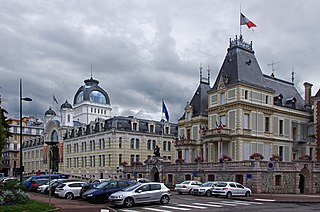Related Research Articles
An arrondissement is any of various administrative divisions of France, Belgium, Haiti, certain other Francophone countries, as well as the Netherlands.

The commune is a level of administrative division in the French Republic. French communes are analogous to civil townships and incorporated municipalities in the United States and Canada, Gemeinden in Germany, comuni in Italy, or municipios in Spain. The United Kingdom's equivalent are civil parishes, although some areas, particularly urban areas, are unparished. Communes are based on historical geographic communities or villages and are vested with significant powers to manage the populations and land of the geographic area covered. The communes are the fourth-level administrative divisions of France.

The administrative divisions of France are concerned with the institutional and territorial organization of French territory. These territories are located in many parts of the world. There are many administrative divisions, which may have political, electoral (districts), or administrative objectives. All the inhabited territories are represented in the National Assembly, Senate and Economic and Social Council and their citizens have French citizenship and elect the President of France.

Centre is one of the ten departments of Haiti, located in the center of the country along the border with the Dominican Republic. As of 2015, its estimated population was 746,236. Its capital is Hinche.

Carrefour is a largely residential commune in the Port-au-Prince Arrondissement, in the Ouest department of Haiti. The commune had a population of 373,916 at the 2003 census, and was officially estimated to have grown to 511,345 inhabitants in 2015. It is mostly a bedroom community for those who work in central Port-au-Prince.

An administrative center is a seat of regional administration or local government, or a county town, or the place where the central administration of a commune is located.

The Departments of Niger are subdivided into communes. As of 2005, in the seven Regions and one Capital Area, there were 36 départements, divided into 265 communes, 122 cantons and 81 groupements. The latter two categories cover all areas not covered by Urban Communes or Rural Communes, and are governed by the Department, whereas Communes have elected councils and mayors. Additional semi-autonomous sub-divisions include Sultanates, Provinces and Tribes (tribus). The Nigerien government estimates there are an additional 17000 Villages administered by Rural Communes, while there are over 100 Quartiers administered by Urban Communes.
Bombardopolis is a commune located in the hilly country of the Môle-Saint-Nicolas Arrondissement, in the Nord-Ouest department of Haiti.

An arrondissement of Haiti is a level of administrative division in Haiti.

In the administrative divisions of Haiti, the department is the first of four levels of government. Haiti is divided administratively into ten departments, which are further subdivided into 42 arrondissements, 145 communes, and 571 communal sections.

A Commune is the third-level administrative unit in Mali. Mali is divided into eight regions and one capital district (Bamako). These subdivisions bear the name of their principal city. The regions are divided into 49 Cercles. The Cercles and the district are divided into 703 Communes, with 36 Urban Communes and 667 Rural Communes, while some larger Cercles still contain Arrondissements above the Commune level, these are organisational areas with no independent power or office. Rural Communes are subdivided in Villages, while Urban Communes are subdivided into Quartier. Communes usually bear the name of their principal town. The capital, Bamako, consists of six Urban Communes. There were initially 701 communes until the Law No. 01-043 of 7 June 2001 created two new Rural Communes in the desert region in the north east of the country: Alata, Ménaka Cercle in the Gao Region and Intadjedite, Tin-Essako Cercle in the Kidal Region.
Acul-du-Nord is a commune in the Acul-du-Nord Arrondissement, in the Nord department of Haiti.
Ferrier is a commune in the Fort-Liberté Arrondissement, in the Nord-Est department of Haiti. It had 14,642 inhabitants as of 2015.
Perches is a commune in the Fort-Liberté Arrondissement, in the Nord-Est department of Haiti. It had 11,556 inhabitants as of 2015.
Jean-Rabel is a commune located west of the city of Port-de-Paix and east of the city of the Môle-Saint-Nicolas Arrondissement, in the Nord-Ouest department of Haiti. As of 2015, the estimated adult population was 148,416.
Port-de-Paix is an arrondissement in the Nord-Ouest department of Haiti. As of 2015, the population was 336,650 inhabitants. Postal codes in the Port-de-Paix Arrondissement start with the number 31.

The communal section is the smallest administrative division in Haiti. The 144 communes are further divided into 571 communal sections.
Liancourt is a commune in the Saint-Marc Arrondissement, in the Artibonite department of Haiti. Once a communal section, a presidential decree on 22 July 2015 made it a commune.
Lapointe is a commune in the Port-de-Paix Arrondissement, in the Nord-Ouest department of Haiti. Once a communal section, a presidential decree on 22 July 2015 made it a commune.
References
- ↑ Olivier, Louis-Joseph, ed. (14 August 2015). "Création de cinq nouvelles communes par décret présidentiel" (in French). Le Nouvelliste. Retrieved 6 June 2017.
- ↑ Press, ed. (16 August 2015). "Haïti - Politique : 5 nouvelles communes en Haïti". Haiti Libre. Retrieved 6 June 2017.
- ↑ "Mars 2015 Population Totale, Population de 18 ans et Plus Menages et Densites Estimes en 2015" (PDF). Institut Haïtien de Statistique et d’Informatique (IHSI). Archived from the original (PDF) on 6 November 2015. Retrieved 6 June 2017.
- ↑ Press, ed. (March 2002). "Organisation Territoriale des Collectivités" (PDF) (in French). Commission nationale a la reforme administrative (CNRA). Archived from the original (PDF) on 17 May 2018. Retrieved 6 June 2017.
